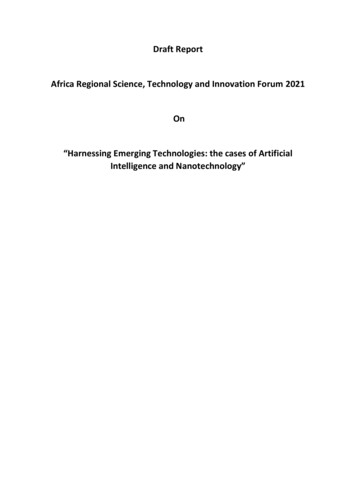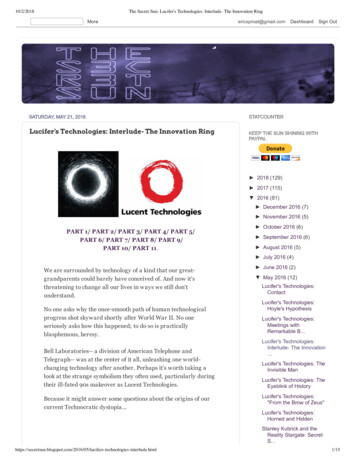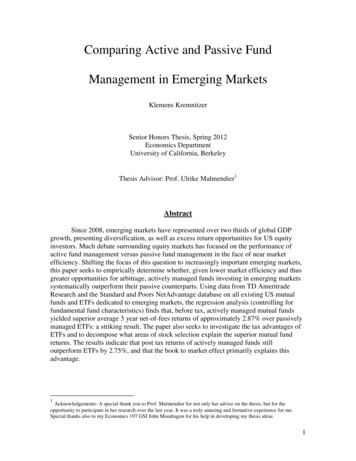
Transcription
OCTOBER 2019MWRF - Microwaveeuropeanbusiness presswww.mwee.comEmergingTechnologiesThe European journal for the microwaveand wireless design engineer
Editor In ChiefJean-Pierre JoostingTel. 44-7800 dvertising ProductionLydia GijsegomMWRF - MicrowaveTel 32 (0) 2 740 00 50lydia.gijsegom@electronicseurope.netCirculation & FinanceLuc DesimpelTel 32 (0) 2 740 0055luc.desimpel@electronicseurope.netArt ManagerJean-Paul SpeliersTel 32 (0)2 740 tingRicardo Pinto FerreiraContents84-7NewsNewsFiber-like Internet coming to theArcticSatellite swarm to enableubiquitous 5GAtomic receiver works withcommon communicationssignalsTel 32 (0)2 740 0051financial@electronicseurope.netPublisherAndre RousselotTel 32 (0)2 740 0053andre.rousselot@electronicseurope.netEuropean Business Press SA533 Chaussée de Louvain1380 Lasne - BelgiumTel: 32 (0)2 740 00 50Fax: 32 (0)2 740 00 59www.mwee.comVAT Registration: BE 461.357.437RPM: NivellesCompany Number: 0461357437 2019 E.B.P. SA All rights reserved. No part of thispublication may be reproduced ortransmitted in any form or by anymeans, electronic or mechanical,including photocopying, recording orany information storage or retrievalsystem without the express prior writtenconsent of the publisher. The contents of Microwave EngineeringEurope are subject to reproductionrights in information storage andretrieval systems. MWee RF & Microwave is publishedseven times a year. Apply for a freecopy of the journal online atwww.mwee.com/subscribe Subscriptions: Microwave EngineeringEurope is available on subscriptionto others at 150 Euro. Refunds oncancelled subscriptions will only beprovided at the Publisher’s discretion,unless specifically guaranteed within theterms of the subscription offer.Paid subscription queries tel: 32 2 740 00 50 Printed by Perkawww.mwee.com10, 12Emerging Technologies: SmartNetworks Put the IoT on theMapMultiprotocol ConnectivityAddresses the Challenges ofManaging and Updating IoTDevices on sub-GHz Networks14Emerging Technologies:Integrated Transceivers EnableSmall Form Factor PhasedArray Radar PlatformsTiny energyharvestingtile for IoTsensorsoutputsover 1-mW18, 20Emerging Technologies: Solvingthe Tough Timing Challenges of5G Wireless InfrastructureEmerging Technologies: IoTdevices could be powered byNeutrinoenergydevices22ProductsWi-Fi 6 routerreference designPocket-sized USB spectrumanalyzersOctober 2019MW3
NewsIridium and OneWeb MOU oncombined satellite servicesIridium Communications and OneWebhave entered into a Memorandum of Understanding (MoU) to worktogether toward a combined LEO satellite serviceoperating in the Ku-bandand L-band. This combinedsatellite service offeringwould be designed to makeit easier for their mutualpartners to offer unique bundling andco-marketing opportunities for the IridiumCertus L-band services and OneWeb'sKu-band service. This is the first time thatLEO operators have collaborated to deliver services in L-band and Ku-band andwould leverage the strengths of their respective low-Earth-orbit (LEO) networks.The MoU also creates opportunitiesfor companies that manufacture bothOneWeb and Iridium CertusTM terminals. Such new options could includeIridium-OneWeb companion packagesin addition to providers being able tooffer combined equipment or even newdual-constellation terminals.Due to the physics associated withL-band and Ku-band spectrum, thetwo come with different yet complementaryattributes. The OneWebnetwork will deliver veryhigh-speed broadbandconnectivity that transferslarge amounts of data. Itis ideal for applicationsincluding Inflight WiFi, Government, andMaritime networks that require globalreach, high speed and low latency. Iridium's crosslinked satellite constellationbrings seamless truly global connectivitywith highly weather resilient L-band userterminals, making it uniquely suited toprovide safety services for ships, aircraft,vehicles and deployed personnel, withregulation-required capability. These twonetworks can work together to delivercapacity, resiliency, and fast connectivityto customers anywhere in the world.www.iridium.comwww.oneweb.worldFirst LTE-M VoLTE call onEuropean network infrastructureSwiss company, u-blox has announcedthat, in conjunction with telecom operator Swisscom, it has completed a Voiceover LTE (VoLTE) call across a live LTE-Mcellular low power wide area network(LPWAN). This is the first time such a callhas ever been achieved in Europe. Thecall was made over Swisscom’s LTE-Mnetwork, using a u-blox LTE-M evaluationkit. It followed on from preliminary teststhat had been conducted at Swisscom’slaboratories and live network, where anarray of different voice-related alarm andemergency functions were all validated.The test configurations included calls froma mobile handset to a landline phone, alandline phone to a mobile, and mobileto mobile, as well as hand-over switchingbetween multiple LTE-M base stations.VoLTE enables voice communicationon packet-switched 4G networks. Beingable to deliver voice calls directly overLTE-M represents a major technologicaladvance for the industry. Such LPWAN4MWOctober 2019SoC enables affordablemobile paymentterminalsA single-chip controller developed bySTMicroelectronics and mobile paymentdisruptor YouTransactor is set to makecard payment terminals even more affordable and ubiquitous.The single-chip controller is the firstPCI secure System-on-Chip (SoC) formobile payment terminals to be basedon a general-purpose microcontroller forrobust performance and low power ata cost-effective price. It was developedthrough a combination of YouTransactor’s market knowledge and intellectualproperty of security and point-of-sale payment terminals and applications, and ST’schip-design skills and intellectual propertyincluding cyber-protection and sophisticated display-graphics control,The YTSECPCI SoC commercialized byYouTransactor with the support of ST hasalready been embedded and deployed in50,000 payment terminals, with over 1 million units ordered for 2019-2020. To furtheraid development, a dedicated evaluationboard and reference design is available.www.youtransactor.com5G commercial markettakes offnetworks are designed to prolong thebattery life of IoT devices and providebetter in-building coverage. It also meansthat circuit-switched 2G or 3G voiceconnections no longer have to be reliedupon, and the necessary infrastructurecan be significantly reduced. Consequently the costs that OEMs face, interms of constituent hardware andimplementation effort, can be dramatically reduced. Furthermore, it ensures thatOEMs have future proofed themselvesagainst the planned shutdown by manyoperators of their legacy 2G services.Building automation, connected healthand automotive are among the sectorsthat can derive benefits from VoLTE utilizing LTE-M. Some key use cases includemobile personal emergency responsemonitors, connected elevators, car crashreporting mechanisms, fire prevention,residential security, and so on.Developing much more quickly than theprevious generation 4G LTE standard,the 5G market has seen a total 31 5Gcommercial service launches globally bythe end of the second quarter of 2019,according to the latest 5G research reportfrom IHS Markit Technology.The report finds that amid a burstof launches in the second quarter, thedeployment of 5G commercial serviceshas become widespread, with projects in17 countries in Asia, Europe, the MiddleEast and North America. This level ofdeployment was achieved just 10 monthsafter the first commercial 5G launches,which IHS Markit Technology tracesback to August 2018. In contrast, 4Gtook about three years to begin deployment and four years to attain a largenumber of launches.A major factor driving the accelerationin the pace of launches is the maturity and experience of today’s gy.ihs.comwww.mwee.com
You Engineer the Future.We’ll Supply the Components. Today!Largest Selection p Same-Day Shipping p Expert Technical Support pArmed with the world’s largest selection of in-stock, ready to ship RF components, and the brains to backthem up, Pasternack Applications Engineers stand ready to troubleshoot your technical issues and thinkcreatively to deliver solutions for all your RF project needs. Whether you’ve hit a design snag, you’re lookingfor a hard to find part or simply need it by tomorrow, our Applications Engineers are at your service.USA (949) 261-1920AUSTRIA (49) 89 4161 5994 0BELGIUM (31) 229 50 34 78CZECH REPUBLIC (420) 235 365 207DENMARK (46) 8 554 909 50FINLAND (46) 8 554 909 50FRANCE (33) 1 47 95 99 60GERMANY (49) 89 4161 5994 0IRELAND (44) 0 1420 544789ISRAEL (972) 9 741 7277ITALY (39) 06 4071603KAZAKHSTAN (7) 495 961 34 43LUXEMBOURG (31) 229 50 34 78NETHERLANDS (31) 229 50 34 78Pasternack.comNORWAY (46) 8 554 909 50POLAND (48) 22 855 34 32PORTUGAL (34) 91 636 3939RUSSIA (7) 495 961 34 43SLOVAKIA (420) 235 365 207SPAIN (34) 91 636 3939SWEDEN (46) 8 554 909 50SWITZERLAND (49) 89 4161 5994 0TURKEY (90) 216 504 07 87UKRAINE (7) 495 961 34 43UNITED KINGDOM (44) 0 1420 544789
NewsFiber-like Internet coming to theArcticStarting in 2020, OneWeb aims to delivera high-speed, low-latency internetservice to the Arctic thatwill deliver 375 Gbpsof capacity above the60th parallel North. Theinternet service providesenough capacity to givefiber-like connectivity tohundreds of thousandsof homes, planes, and boats, connectingmillions across the Arctic.The first to provide full coverage tothe region, OneWeb’s fiber-like internetwill enable under-served, and unconnected communities in the artic to benefitfrom broadband connectivity. The service will help advance maritime, aviation,enterprise, government and scientificresearch needs.The dense, flexible coverage ofOneWeb's polar-orbiting satellitescoupled with its high-speed serviceand low latency capabilities will providea superior connectivity experience tothe 48% of the Arctic currently withoutbroadband coverage. OneWeb recentlyproved its system's capabilities throughHD video streaming testslast month with its first sixsatellites that showcasedextreme low latencies under 40 milliseconds andhigh speed services.The Arctic service willbe deployed significantlyearlier and provide 200 times more capacity than planned systems. Substantialservices will start towards the end of2020, with full 24-hour coverage beingprovided by early 2021, supplying unprecedented blanket coverage to every partof the Arctic Circle. OneWeb is alreadyactive in Norway and Alaska, where itsground antennas will be fully operational by January 2020. One of OneWeb'sfirst operational satellites in orbit is alsonamed Nanuq-Sat after the Inuktitutword for polar bear and was named bychildren in Anchorage, Alaska.Ren Zhengfei, CEO of Huawei Technologies Co. Ltd., has offered to let Westerncompanies license 5G technology allowing them to take software and modifyit, according to reports. The move wouldappear to be an attempt to foster USinfrastructure companies and let Huaweitake some income from 5G marketswhere it is currently banned as a result ofa US-China trade war."[Huawei is] open to sharing our 5Gtechnologies and techniques with UScompanies, so that they can build uptheir own 5G industry," the New YorkTimes quoted Ren, as saying. "Thiswould create a balanced situationbetween China, the US and Europe."In the Economist Ren said: "A balanced distribution of interests is conducive to Huawei's survival."The licensing could be advantageousto Huawei in helping to establish polarcodes as the de facto method of encoding data, an area in which Huawei has astrong patent position can could therefore take advantage.www.oneweb.worldwww.huawei.comGroup to advance pluggabletransceiver speeds to 800 GbpsThe QSFP-DD800 Multi-Source Agreement (MSA) Group has been created byseveral industry leaders to advance thedevelopment of high-speed, double-density quad small form factor pluggabletransceiver (QSFP-DD800) modules tosupport 800 Gbps connectivity.The MSA group will help to addressthe increased global bandwidthconsumption by enabling very high bandwidth interfaces. The MSA founder-promoters include Broadcom, Cisco, Finisar,Intel, Juniper Networks, Marvell, Molexand Samtec.The new QSFP-DD800 interfaceexpands on the QSFP-DD, a pluggableform factor with an eight-lane electricalinterface widely adopted by the latestEthernet switches. This MSA will enableQSFP-DD800’s eight electrical lanes tooperate at 100 Gigabit per second (Gbps)each, by providing technical solutionsfor 800 Gbps module and connectorsystems. It will also define a module,6MWOctober 2019Huawei offers to license5G technologyQinetiQ signs deal todevelop secure satellitenavigation receiversconnector, stacked connector and ahybrid connector that is a BiPass/Flyovervariant which can eliminate the signallosses on a traditional PCB.The primary objective of the MSAGroup is to define the specifications andpromote industry adoption of the QSFP-DD800. The new QSFP-DD800 specification is intended to be backward compatible with QSFP-DD, QSFP28 and QSFP modules and cables in order to addressthe upcoming industry demands of 25.6Tb/s scale systems supporting dense 100GbE or dense 400 GbE interfaces.“The QSFP-DD form factor continuesto be the cornerstone for the next stepin pluggable module performance anddensity, while extending the industry’sinvestment, experience, cost structureand backward compatibility from priorgenerations” said Mark Nowell, foundingmember and MSA co-chair.QinetiQ has signed a contract with theMinistry of Defence (MOD) DefenceEquipment and Support (DE&S) worth 67m to develop secure multi-constellation satellite receivers. The project, underthe UK Robust Global Navigation System(R-GNS) programme, aims to provideaccurate and resilient positioning, navigation and timing (PNT) for military operations around the world using the Galileosatellite contellation as well as GPS andthe Russian and Chinese networks.QinetiQ will use its advanced processing technologies for secured navigationfor use by individuals and platformsincluding autonomous land, maritime andair systems such as drones. It is workingwith Collins Aerospace and sub-contractors Roke Manor Research, RaytheonSystems, Nottingham Scientific andPhixos to design and make the satellitereceivers in the UK and free of the USITAR technology mwee.com
NewsOperators to facilitateO-RAN testing andintegrationA group of leading global operators,vendors and integrators have launchedthe Open Test and Integration Center(OTIC) initiative, which aims to acceleratemulti-vendor, open and disaggregatednext generation 5G wireless infrastructureby providing test and integration centersto facilitate product readiness. The groupare collaborating on multi-vendor interoperability and validation activities forrealizing O-RAN compliant disaggregated5G access infrastructure that leveragesopen software and hardware hardenedfor commercial deployments.The group comprises China Mobileand Reliance Jio along with participationfrom China Telecom, China Unicom, Intel,Radisys, Airspan, Baicells, CertusNet,Mavenir, Lenovo, Ruijie Network, Inspur,Samsung Electronics, Sylincom, WindRiver, ArrayComm, and Chengdu NTS.The OTIC aim to expedite how theindustry develops open RAN technologies and products that are hardened andsupported for real-world deploymentswww.chinamobileltd.comEutelsat, Sigfox to launchnanosat constellation for IoTEuropean satellite operator EutelsatCommunications is set to launch nanosat constellation comprising25 nanosatellites over thenext three years to provideconnections for devices inthe Internet of Things (IoT).The first two nanosats,each costing up to E1mrather than tens of millionsof euros for larger space systems, will bebuilt by Loft Orbital in San Francisco andthe next two by Clyde Space in Glasgow.The constellation, called ELO, willwork with the Sigfox IoT network acrosstransport, oil and gas, and agricultureapplications. The expected launch datesin 2020 and 2021 will see the first foursatellites enter commercial service assoon as they are reach orbit. If these aresuccessful, other satellites will be addedto the constellation, to reach a total of 25satellites operational by 2022.This constellation project follows onfrom an initial nanosatellite ordered byEutelsat from Tyvak International last yearand planned for launch early next year.This test satellite will confirm the technicalperformance of variouswaveforms between a satellite in low Earth orbit andobjects on the ground. Thestrategic partnership withSigfox, which will integratethe global coverage provided by the ELO constellation into its existing range of IoT connectivity services. This opens up applicationsin areas like maritime transportation orlogistics, but also the safety of people inemergency situations.“Our partnership with Sigfox enables worldwide coverage through thecombination of satellite and terrestrialIoT. This relatively modest investmentat Group level, which is fully scalable,enables Eutelsat to access an additionalpotential growth lever in the context ofits Connectivity strategy,” said RodolpheBelmer, CEO of Eutelsat.www.eutelsat.comSatellite swarm to enable ubiquitous 5GA consortium of industry and scienceorganisations is developing a softwareplatform to enable a satellite-based communications layer to supplement for terrestrial 5G mobile communications andenable nationwide coverage in Germany.The space industry is changing asmore and more private players arepushing their way into the state-dominated market and bringing along newbusiness models. One consequenceis the increased use of small satellites,which are inexpensive and flexible to usecompared to previous large and expensive satellites.According to a consortium led byProfessor Armin Dekorsy (University ofBremen, Germany), this trend, which isoften summarized under the buzzword"New Space", offers the opportunity tosupply Germany with 5G mobile communications throughout the country. Together, the participants will first developa software platform for evaluating andoptimizing the latest 5G communicationtechnologies for satellite networks andtheir mission planning.www.mwee.comTo this end, the University of Bremen,DSI Aerospace Technologie GmbH,OHB System AG and ZARM Technik AGis part of the 5GSatOpt project ("Design, Evaluation and Optimization of 5GSatellite Constellations for the Internet ofEverything and Everywhere").The problem: by the end of 2022, atleast 98 percent of households in Germany should be able to access 5G, buttelecommunications providers will onlybe able to cover 80 percent of the area.Thus, many rural regions will continue tobe left behind.A network of small satellites canguarantee complete coverage andmake data transmission more efficientoverall. This is possible by sending alarge number of satellites – a so-calledmega-constellation – into a near-earthorbit and networking them with eachother. "In addition to the communicationlevel on the ground, a second level at analtitude of around 1,000 kilometers canbe set up," explains Dekorsy.Dekorsy's working group at the Technology Centre for Computer Scienceand Information Technology (TZI) at theUniversity of Bremen has been involvedin the development of the 5G mobileradio standard from the very beginningand has the necessary expertise in communications engineering. The workinggroup Optimization and Optimal Controlat the Center for Technomathematicsat the University of Bremen contributesknow-how in the optimization of complex systems, while ZARM focuseson mission planning. ZARM Technikaddresses the alignment of satellites inspace, while OHB and DSI have decades of experience in the design ofsatellites and communication modules.In addition to Internet access in ruralareas, such a network of small satellitescould also be used for other purposes,such as earth observation and climateresearch.The project is supported by the Stateof Bremen with funds from the EU toptOctober 2019MW7
NewsAtomic receiver works with commoncommunications signalsA new type of radio receiver sensor thatuses atoms to receive commonly usedcommunications signals has been demonstrated by researchers at the NationalInstitute of Standards and Technology(NIST). This atom-based receiver has thepotential to be smaller and work betterin noisy environments than conventionalradio receivers, among other possibleadvantages. Cesium atoms were usedto receive digital bits (1s and 0s) in themost common communications format ofphase shifting or phase modulation. Here,radio signals or other electromagneticwaves are shifted (modulated) relative toone another over time and the information(or data) is encoded in this modulation."The point is to demonstrate that onecan use atoms to receive modulatedsignals," project leader Chris Hollowaysaid. "The method works across a hugerange of frequencies. The data rates arenot yet the fastest out there, but thereare other benefits here, like it may workbetter than conventional systems innoisy environments."In their paper, the team described aquantum sensor that received signalsbased on real-world phase-shiftingmethods. A 19.6 GHz transmissionfrequency was chosen because it wasconvenient for the experiment, but it alsocould be used in future wireless communications systems, Holloway said.The NIST team previously used thesame basic technique for imaging andmeasurement applications. Researchersuse two different colour lasers to prepareatoms contained in a vapour cell intohigh-energy ("Rydberg") states, whichhave novel properties such as extremesensitivity to electromagnetic fields.The frequency of an electric field signalaffects the colours of light absorbed bythe atoms.Wireless communications often use aformat called phase shifting or phasemodulation, in which the signals areshifted relative to one another in time.In this example, the communicationssignal (blue) contains periodic reversals relative to the reference signal(red). These reversals are the blips thatlook like cats' ears. The information (ordata) is encoded in this modulation.Image courtesy of Holloway/NIST.In the new experiments, the team useda recently developed atom-based mixerto convert input signals into new frequencies. One radio-frequency (RF) signal actsas a reference and a second RF signalserves as the modulated signal carrier.Differences in frequency and the offsetbetween the two signals were detectedand measured by probing the atoms.While many researchers have previously shown that atoms can receiveother formats of modulated signals, theNIST team was the first to develop anatom-based mixer that could handlephase shifting.Depending on the encoding scheme,the atom-based system received up toabout 5 megabits of data per second.This is close to the speed of older,third-generation (3G) cell phones.The researchers also measured theaccuracy of the received bit streambased on a conventional metric callederror vector magnitude (EVM). EVMcompares a received signal phase tothe ideal state and thus gauges modulation quality. The EVM in the NISTexperiments was below 10 percent,which is decent for a first demonstration, Holloway said. This is comparableto systems deployed in the field, headded.With further development, atombased receivers may offer many benefitsover conventional radio technologies,according to the paper. For example,there is no need for traditional electronics that convert signals to different frequencies for delivery because the atomsdo the job automatically. The antennasand receivers can be physically smaller,with micrometer-scale dimensions. Inaddition, atom-based systems may beless susceptible to some types of interference and noise. The atom-based mixeralso can measure weak electric fieldsprecisely. The researchers now plan toimprove the new receiver by reducinglaser noise and other unwanted effects.REFERENCEPaper: C.L. Holloway, M.T. Simons, J.A.Gordo and D. Novotny. 2019. Detectingand Receiving Phase Modulated Signalswith a Rydberg Atom-Based Receiver.IEEE Antennas and Wireless PropagationLetters. September 2019 issue. DOI:10.1109/LAWP.2019.2931450www.nist.govWireless power chip market to soarA report form IHS Markit Technologyexpects the market for wireless powerchips to top 2bn units by 2023 with largegrowth in the automotive sector. Globalshipments of wireless power receivers(Rx) and transmitters (Tx) are set to morethan triple from 2018 to 2023.8MWOctober 2019Combined Rx and Tx shipments willrise to 2.1bn units in 2023, rising at aCAGR of 28.2 percent from 611 million in2018, as reported by the Wireless PowerMarket Tracker – Q1 2019 report fromIHS Markit Technology. The expansionis driven by broad-based demand frommultiple markets, including wearables,computing, medical, smart homes,kitchen appliances, power tools, robotics,industrial, infrastructure, electric vehiclesand automotive in-cabin systems.www.ihsmarkit.comwww.mwee.com
Smart Solutions to Accelerate DesignBuilding Blocks to Optimize Your Design’s IntelligenceAs technology has evolved, more and more devices demand intelligent systems.Microchip has been on the forefront of this evolution, bringing you a broad portfolio ofsolutions that helps you: Easily find the right level of intelligence for your design with our broad portfolio of8-, 16- and 32-bit MCUs, DSCs and MPUs Efficiently create differentiated designs with flexible peripherals and functions Accelerate design time with our intuitive development environments, completereference designs, free software libraries and automatic code generation tools.Learn how Microchip can get you to production faster by providing solutions thatare not only smart, but also connected and secure.Get smart at www.microchip.com/SmartThe Microchip name and logo and the Microchip logo are registered trademarks of Microchip Technology Incorporated in the U.S.A. and other countries. Allother trademarks are the property of their registered owners. 2019 Microchip Technology Inc. All rights reserved. DS00002769A. MEC2237A-Eng-06-19
IoTSmart Networks Put the IoT on the MapBy Richard Lansdowne, Senior Director of LoRa Cloud Services, Semtech CorporationAs the Internet of Things (IoT), growsa key demand for devices is that theyor the systems that interact with themknow where they are located. It is becoming important even for devices that arenot expected to be mobile in normal use.By making it possible to determine adevice’s physical location when it joinsthe network, the process of commissioning and provisioning can be almostentirely automated. The only manualintervention comes when placing thedevice itself at the destination. Thereneeds to be no doubt that an environmental sensor, for example, is recordingvalues from a particular point. By updating location at regular intervals, operators can also be sure that a sensor hasnot been moved, either inadvertently ordeliberately, to be sure it is not takinginaccurate readings.For other applications, the regulardetermination of location is a vital aspect of asset management and servicedeployment. For example, farmers wantto be sure that automated fertiliser andpest-control systems are working asexpected and treating fields correctly. This can be monitored using fixedsoil sensors as well as trackers in themechanical systems used to deliver thetreatments.Some implementors have turnedto various forms of Global NavigationSatellite System (GNSS) receivers toprovide the location information theirdevices and related IoT services require. Although there are now multipleconstellations in orbit that can provide the necessary positioning signals,GNSS protocols have a commonapproach. Each satellite has onboarda highly accurate atomic clock. The receiver can use comparisons of the timeof arrival of the clock signals sent outby these satellites in conjunction withephemeris databases to determine theirlocation anywhere in the world, just aslong as sufficient satellites are in view.There are several drawbacks associated with GNSS-based location. Oneis device cost. The GNSS processorneeds to be able to receive the comparatively weak signals sent by orbitingsatellites, decrypt the messages eachof them provides and compare real-10MWOctober 2019time signals over a period oftime. This consumes significantcompute resource, which eitherdemands a more powerful hostprocessor in the IoT node orsome form smart coprocessor.The second drawback is one ofenergy consumption. To be ableto determine position accurately, the GNSS receiver needsto be active for long periods oftime during which it is activelylistening to the RF channels.Figure 1 - Signal propagation means strengthAs a result, there are severemeasurements lose accuracy with distance andrestrictions on how many battery-powered applications can they are also adversely affected by obstructionssuch as windows.use GNSS economically.An alternative approach isto employ existing terrestrialcommunication systems suchas Bluetooth, cellular or WiFi.This can be achieved even ifthe core protocol does not provide direct support for locationservices. In these systems,signal strength acts as a proxyfor distance between the IoTdevice and each of the basestations from which the deviceis able to receive signals. Akey advantage of using signalFigure 2 - Time of flight for RF transmission isstrength is that it does notlargely unaffected by obstructions and is directlyrequire any actual connectionproportional to distance from the transmitter.to the protocol in the devicegth is exacerbated by obstructions suchat all, which lets implementorsas walls and windows. A problem thatcreate positioning systems without neewill be common to systems deployedding active cooperation from softwareinside a building. Similarly, signalsrunning in the basestations. The keyaffected by reflections and in
Emerging Technologies 190830_7-9_Mill_MWE_EU_Snipe.indd 1 8/22/19 11:55 AM. 190830_NOIM_MWE_EU.indd 1 8/22/19 1:28 PM. . 5G Wireless Infrastructure Emerging Technologies: IoT devices could be powered by Neutrino energy devices RF - Microwave MW 8 News Atomic receiver works with common communications signals 4-7










